Dental tools like toothbrushes, floss, and other teeth cleaning gadgets make up a multi billion dollar industry. There are so many different oral health care tools on the market that it can sometimes be overwhelming when trying to pick the best option for your mouth. Some are electronic, many are not, and it is often difficult to know which ones really are more effective in keeping your oral health in check.
Do electric toothbrushes really clean better than traditional ones? What can waterpiks do that normal floss can’t? To help make it easier, we have laid out the pros and cons of powered and traditional versions of two tools that you use twice daily to clean your teeth: the toothbrush and floss.
Electric toothbrushes
Pros: A huge advantage to the electric toothbrush is that it is generally more enticing and seems to be more fun to use. This is a great aspect for those who are reluctant to brush twice each day, and especially for children, as it can inspire enthusiasm to brush. This is a clear case where electric toothbrushes can be more effective than manual toothbrushes.
Electric toothbrushes can be a time saver and can do a more thorough cleaning job as they provide between 6,000 and 30,000 strokes per minute. This means that it can take less time to properly clean your teeth, however this doesn’t mean that quickly running the toothbrush over the teeth will be as effective as a manual toothbrush. Ensuring that every tooth is thoroughly cleaned is still as vitally crucial as ever.
For those who do not have the dexterity or grip needed to operate a manual toothbrush, an electric toothbrush is a great option as it is easy to hold and takes care of the rotating action for you.
Cons: Even cheap electric toothbrushes typically cost more than a manual toothbrush, and higher quality ones are significantly more. Along with the initial cost of the unit and its charging base, the heads should be replaced just as frequently as a manual toothbrush should be, and these can be pricey depending on the toothbrush model type.
The bulk of an electric toothbrush can be a huge con, especially for those who travel or highly value counter space in the bathroom. The toothbrush itself is about double the size of a manual toothbrush and it comes with a variably-sized charging station that you’ll need to consider.
Some people find the vibrations created by the toothbrush to be aggravating, or even painful. Those with gum issues, loose teeth, or general sensitivity should seriously consider another brushing method, as controlling the pressure and vigor of an electric toothbrush can be very difficult.
Pros: The biggest pro to manual toothbrushes is that you have more control over the way that you brush your teeth. You can decide how fast and how hard to brush your teeth, gums, cheeks, and tongue. This results in a more comfortable cleaning for those who have sensitive areas in their mouth or who find the constant vibrations of electric toothbrushes to be aggravating.
Manual or traditional toothbrushes are a much more cost effective option than their electric counterparts, costing well under $10. They do not take up much room either, making travel and storage very easy, especially since there are no additional parts.
There is very little that can go wrong with a manual toothbrush as there are no batteries to charge or accessories needed. It is the simplest option with nothing to fiddle with like replacement heads or power buttons.
Cons: Manual toothbrushes rely on the user having excellent brushing technique in order to thoroughly clean teeth and the mouth. This is an issue for those who do not take the time to properly brush their teeth and who miss spots. This can also present problems for those who find handling a toothbrush to be difficult. In order to thoroughly clean the mouth, quite a bit of dexterity is needed and a manual brush may not be the best option for those who find this challenging. Also, people with motor difficulties, arthritis, or any other number of conditions may find manual toothbrushes to be more challenging than their electric brethren.
Manual brushes also may not have the same allure as an electric toothbrush, and this can result in a lacklustre attitude towards brushing. For children, manual brushes do come in fun colours that feature cartoon characters. But for adults who prefer more high tech options, manual toothbrushes are the less enjoyable option. Where are the adult versions of the Batman or My Little Pony toothbrush, we ask!
Water Flossers
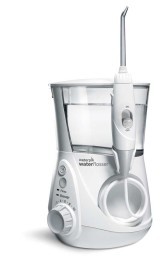
Pros: The main advantage to the water flosser, or the brand name it’s more commonly known by – the Waterpik® – is that it provides an alternative to those who choose not to floss. The device shoots out a stream of water that users can aim between teeth. This can help to remove food particles from between teeth which can otherwise lead to tooth decay or gingivitis if not removed.
It is a fine option for people who would otherwise do nothing to clean in between teeth, and for some can inject a sense of novelty and fun into the teeth cleaning process. We believe that any tool that makes users more enthusiastic about their own oral care is a good tool to use!
Water flossers may also be easier to operate for those who have a hard time using their hands or do not have the dexterity needed to use floss, providing a decent alternative to fiddly floss strings.
Cons: Unfortunately, they do not do as good of a job cleaning plaque off of teeth as traditional floss does. The stream of water that hits the teeth can pass over built up plaque and tartar and does not have the strength needed to clean deeply between teeth. In general, dentists do not consider water flossers to be a substitute to brushing and flossing but rather an additional step in the mouth cleaning process.
Water flossers can be quite expensive, too, easily costing anywhere from $20-$100. The initial purchase of a water pick can be costly, as well as any replacements needed should something not operate properly.
Floss
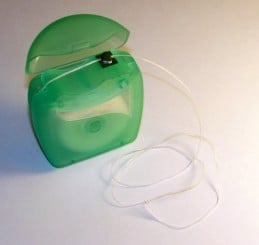
Pros: Traditional floss is still the most effective tool in scraping plaque and tartar from the sides of teeth and removing food particles from between them. Because it is flexible it can curve around teeth to clean all sides of each tooth, and it can be pulled taut to scrape off stubborn residue.
Traditional floss is the most cost effective dental tool on the market, costing less than five dollars per package, and you can monitor how much of it you want to use. It also comes in unwaxed or waxed versions with various flavours to make it easy to customize your flossing routine.
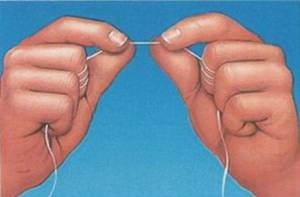
Because you operate floss with your own two hands and nothing else, you have total control over where the floss goes in your mouth and how much pressure is applied. This can be important for those with sensitive areas in their mouths or those who feel more comfortable with more control over their oral cleaning.
Cons: The biggest issue with traditional floss is that some find it difficult to handle as it does require a certain level of dexterity. However, there are options such as tools which provide a handle at the end of a pre-threaded piece of floss. This can be an easier and quicker option for those who do not want to fiddle with strings wound around their fingers.
Unfortunately, many people see flossing as a tedious task and this highlights another issue with traditional floss: it does not have the allure of a more high tech option. Because of this, and surely other reasons, many do not bother to floss at all, in which case traditional floss is completely ineffective. As with all dental tools, in order to be effective, they have to be used.
In the end, the most effective tools for cleaning your teeth are the ones that you will actually use.
If technology excites you and makes the idea of cleaning your teeth twice daily more enjoyable, pick something more high tech. If you are more of a traditionalist, or have a health condition that complicates hand movements, it only makes sense to choose the tool that you are most comfortable with. For more information, ask your dentist about which dental tools are best for you.


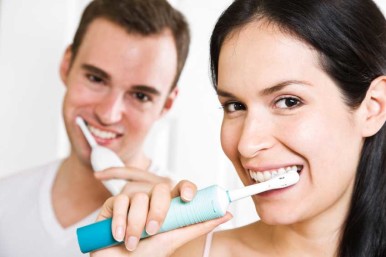
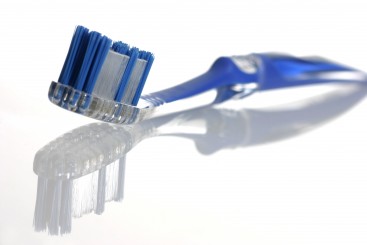



 December is finally here, and if you’re not already hyped about the holidays, you’re about to […]
December is finally here, and if you’re not already hyped about the holidays, you’re about to […]
